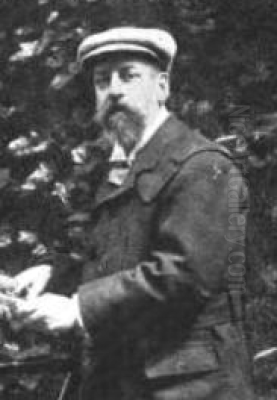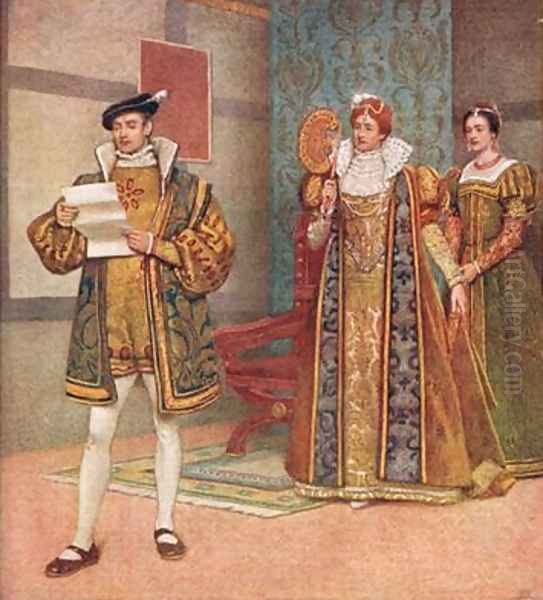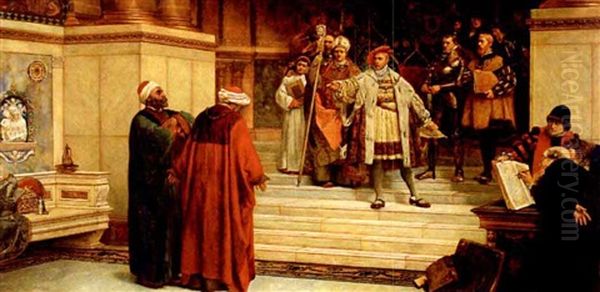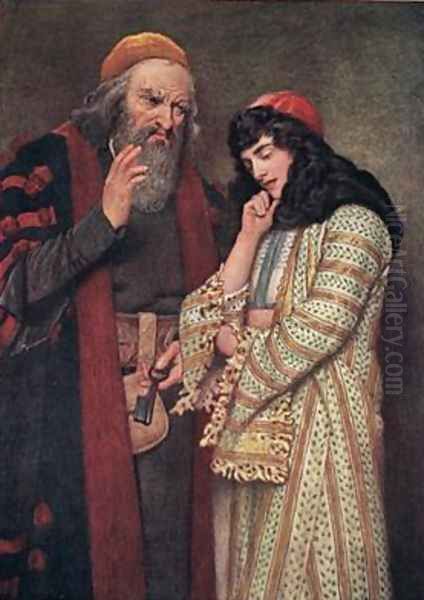
Sir James Dromgole Linton (1840-1916) stands as a significant figure in the landscape of British Victorian art. A versatile and accomplished artist, he excelled in various genres, including portraiture, figure painting, historical scenes, and genre subjects. His technical mastery extended across different media, most notably watercolour, in which he became a leading proponent, but also oil painting and lithography. Linton's career was marked by prestigious appointments, royal patronage, and a consistent output of works that captured the Victorian era's fascination with history, narrative, and meticulous detail.
Early Life and Artistic Formation
Born in London on December 26, 1840, James Dromgole Linton's artistic inclinations emerged early. He pursued formal art education at J.M. Leigh's Art School in Newman Street, a well-regarded institution that provided foundational training for many aspiring artists of the period. Leigh's school was known for its emphasis on drawing from the antique and the life model, essential skills for an artist aiming for a career in figurative and historical painting. This rigorous training would serve Linton well throughout his prolific career.
In his formative years, Linton also gained practical experience as an illustrator and engraver. He contributed to The Graphic, one of the leading illustrated newspapers of the time. This work required him to develop a keen eye for narrative composition and the ability to translate scenes into effective black-and-white images for mass reproduction. Working for such a publication placed him in the company of other notable illustrators like Luke Fildes, Hubert von Herkomer, and Frank Holl, all of whom also successfully transitioned to painting. This early experience in illustration likely honed his storytelling abilities, a crucial aspect of his later historical and genre paintings. He also reportedly worked in stained glass design, an area that would have further developed his sense of colour and composition.
Rise to Prominence in Watercolour
While proficient in oils, Linton made a particularly strong mark in the field of watercolour painting. The 19th century witnessed a golden age for British watercolour, with artists pushing the medium beyond its traditional use for sketches and topographical views into a vehicle for highly finished exhibition pieces. Linton was at the forefront of this movement.

He became an associate of the Institute of Painters in Water Colours (originally the New Society of Painters in Water Colours) in 1867 and a full member in 1870. His dedication and skill were recognized by his peers, leading to his election as Vice-President and, significantly, as President of the Institute in 1884. He held this prestigious position until 1899, and then again from 1909 until his death in 1916. Under his leadership, the Institute received its Royal charter in 1885, becoming the Royal Institute of Painters in Water Colours (RI). This was a testament to the elevated status of watercolour painting and Linton's role within that sphere. His contemporaries in the watercolour world included artists like Myles Birket Foster, known for his charming rural scenes, and Helen Allingham, celebrated for her idyllic cottage paintings, though Linton's subject matter often veered towards more dramatic and historical themes.
Linton's watercolours were characterized by their rich colour, solid drawing, and often elaborate compositions. He treated watercolour with the same seriousness and ambition as oil painting, creating large-scale, highly detailed works that could compete with oils in terms of visual impact. His technique often involved the use of bodycolour (opaque watercolour) to achieve depth and richness, a practice common among Victorian watercolourists aiming for a more substantial effect.
Historical and Genre Painting: A Victorian Fascination
Linton's most enduring reputation rests on his historical and genre paintings, both in watercolour and oil. The Victorian era had an insatiable appetite for scenes from the past, whether grand historical events, literary narratives, or intimate moments of everyday life from previous centuries. Linton catered to this taste with remarkable skill and erudition.
His historical subjects were often drawn from British and European history, particularly the Tudor and Stuart periods, as well as scenes inspired by Shakespearean plays. Works like The Admonition, The Benediction, and The Declaration (a series depicting scenes from the life of a Cardinal) showcase his ability to create convincing historical settings, complete with meticulously rendered costumes and architectural details. His figures are often imbued with a sense of dignity and psychological depth, inviting viewers to contemplate the narratives unfolding before them.
The accuracy of costume and setting was a hallmark of Victorian historical painting, and Linton excelled in this regard. His approach can be compared to that of artists like George Cattermole, an earlier watercolourist known for his historical scenes, whom Linton was sometimes said to rival or even surpass in the richness of his effects. Other contemporaries working in similar historical veins, though often in oil, included Lawrence Alma-Tadema, with his archaeologically precise depictions of classical antiquity, and Frederic, Lord Leighton, President of the Royal Academy, whose works often featured classical and biblical subjects rendered with academic polish. Linton's paintings, while sharing this commitment to detail, often possessed a warmth and narrative accessibility that appealed to a broad audience.
Royal Patronage and Knighthood

A significant milestone in Linton's career was the commission he received from Queen Victoria. In 1882, he was asked to paint The Marriage of H.R.H. The Duke of Albany and Princess Helen of Waldeck-Pyrmont, which took place at St. George's Chapel, Windsor. The painting, a large and complex group portrait and ceremonial scene, was completed in oil and exhibited at the Royal Academy in 1885. This prestigious commission underscored Linton's standing in the art world. Tragically, the Duke of Albany died in 1884 before the painting's exhibition, lending a poignant note to its public display.
In recognition of his contributions to the arts, particularly his leadership of the Royal Institute of Painters in Water Colours and his overall artistic achievements, James Dromgole Linton was knighted in 1885. This honour further solidified his position as one of the leading artists of his generation.
Notable Works and Thematic Concerns
Beyond the royal commission, Linton produced a substantial body of work that was regularly exhibited and well-received. Some of his notable paintings include:
Maundy Thursday (or Washing the Beggars' Feet): This subject, depicting a ritual of humility, allowed Linton to explore themes of piety and social contrast, often set within a richly detailed historical ecclesiastical interior.
Shylock and Jessica and Lorenzo and Jessica: These works, likely inspired by Shakespeare's The Merchant of Venice, demonstrate his engagement with literary themes. He also produced coloured lithographs of these subjects, making his interpretations accessible to a wider public.
The Surrender: A historical scene, likely depicting a moment of military or political capitulation, showcasing his ability to convey drama and emotion.
The Earl of Leicester and Amy Robsart: Drawing from Sir Walter Scott's novel Kenilworth, this subject was popular among Victorian artists, allowing for the depiction of romantic and tragic historical narratives.
Off Guard and The Guard Room: These paintings often depicted soldiers in moments of repose or camaraderie, allowing for detailed studies of historical military attire and character.
Lottie: A portrait or figure study, indicating his work in more intimate genres alongside his grander historical pieces.
His works often explored themes of chivalry, romance, religious devotion, and pivotal historical moments. The attention to detail in costume, armour, and architectural settings was consistently praised, reflecting the Victorian era's interest in historical verisimilitude. Artists like Edwin Austin Abbey, an American expatriate working in Britain, shared a similar passion for historical accuracy and literary subjects, particularly Shakespearean and 17th-century themes.
Involvement with Art Institutions and Exhibitions

Sir James Dromgole Linton was a prominent figure in the London art world, not just as a painter but also as an active participant in its institutions. His long tenure as President of the Royal Institute of Painters in Water Colours (RI) has already been noted. He was also instrumental in the founding of the Royal Institute of Oil Painters (ROI) in 1882, serving as its President from 1883 to 1897 (some sources state 1894-1909 for ROI presidency, indicating possible variations in records or multiple terms). This demonstrates his commitment to promoting both watercolour and oil painting as serious art forms.
He exhibited extensively throughout his career. His works were regularly seen at the Royal Academy from 1863, the primary venue for artists seeking critical and public recognition. He also showed at the Grosvenor Gallery, a more progressive alternative to the Royal Academy founded by Sir Coutts Lindsay, which attracted artists like Edward Burne-Jones and James McNeill Whistler. Other venues included the New Gallery (which succeeded the Grosvenor), the Dudley Gallery, and the Fine Art Society. His involvement with the Royal Scottish Society of Painters in Water Colours (RSW), where he was elected an honorary member, further extended his influence. He was also noted as an honorary president of the Royal Society of Miniature Painters in 1906.
Lithography and Illustration Continued
While his reputation as a painter grew, Linton continued to engage with printmaking. His coloured lithographs, such as those of Shakespearean scenes, helped to popularize his imagery. The Victorian era saw a boom in illustrated books and periodicals, and artists who could work effectively for reproduction were in demand. Linton's early training as an illustrator for The Graphic provided a solid foundation for this aspect of his work. His illustrations for publications like the Sunday Magazine and Quiver further disseminated his art. This engagement with print media was common among Victorian artists; for example, John Gilbert, another prolific historical painter and illustrator, also reached a wide audience through his wood-engraved illustrations.
Artistic Style and Influences
Linton's style can be characterized by its strong draftsmanship, rich and harmonious colouring, and meticulous attention to detail, particularly in the rendering of fabrics, armour, and historical accoutrements. His compositions are generally well-structured, with a clear narrative focus. While primarily a figure painter, some of his historical scenes incorporate landscape elements, and it is noted that his landscape work showed the influence of classical landscape painters like Claude Lorrain and Richard Wilson, though this was not his primary area of focus.

His approach to historical subjects was in line with the prevailing academic traditions of the 19th century, which valued historical accuracy, narrative clarity, and a high degree of finish. He was less experimental than some of his contemporaries who were pushing towards Impressionism or Aestheticism, such as Walter Sickert or Philip Wilson Steer in their later careers. Instead, Linton consolidated and refined the established traditions of historical and genre painting, bringing a particular strength in watercolour to these fields. His work embodies the confidence and historical consciousness of the high Victorian era.
Later Life and Legacy
Sir James Dromgole Linton remained an active and respected figure in the art world until his death. He passed away in Hampstead, London, on December 11, 1916. His legacy is that of a highly skilled and dedicated artist who made significant contributions to Victorian painting, particularly in the realms of historical subjects and watercolour. He played a crucial role in elevating the status of watercolour painting through his leadership of the Royal Institute of Painters in Water Colours.
His daughter, Violet Linton, also became a painter and miniaturist, continuing the family's artistic tradition.
Today, Linton's works are held in various public and private collections. While the grand historical narratives he favored may not be as fashionable as they once were, his paintings are valued for their technical skill, their evocative portrayal of historical periods, and as important examples of Victorian artistic taste and achievement. They offer a window into the cultural preoccupations of his time, reflecting a deep engagement with history, literature, and the enduring power of visual storytelling. His dedication to his craft and his leadership within artistic institutions mark him as a significant contributor to the rich tapestry of 19th-century British art, alongside other stalwarts of the period such as George Frederic Watts, known for his allegorical and portrait paintings, and William Powell Frith, the great chronicler of Victorian contemporary life. Sir James Dromgole Linton's career exemplifies the professionalism and artistic ambition that characterized the Victorian art establishment at its height.